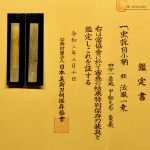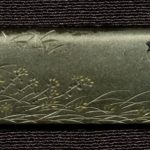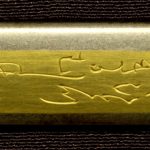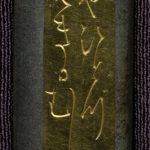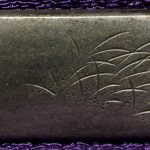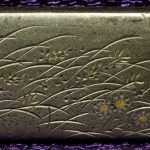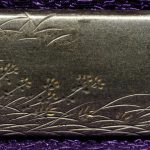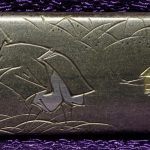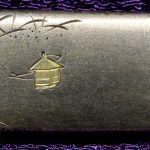GOTO ICHIJO / NBTHK TOKUBETSU HOZON
Goto Ichijo
The maker Goto Ichijo is the last greatest metalworker that the distinguished Goto family produced at the end of their glorious history. He was active at the end of the Edo Period and lived long.
-NBTHK Token Bijutsu
At the end of the line for the Goto family came its greatest artist, Goto Ichijo.
He was born in Kyoto 1791 with the name Eijuro to Goto Jujo of the Shichiroemon line of the Goto family. He studied under his adopted father Goto Kenjo (Hachirobei) until the age of nine, and then Hanzaemon Kijo. When Kenjo died in 1805, Ichijo inherited the Hachirobei line at the young age of only fifteen years old and changed his name to Mitsutaka, and in 1811 changed to Mitsuyuki.
At this time he began doing work for the Edo branch (Shirobei) and some time after this began signing as Mitsuyo (around 1820). His work at this point began its rise to excellence and many Juyo exist today with this Mitsuyo signature.
Already at only the age of 34 in 1824 he was given the task to decorate the Masamune bin the Imperial Collection of Emperor Kokaku. Because of the excellent work done for the Emperor he was given the rank of Hokkyo and changed his name to Ichijo. By 1851 his reputation rose to the point that the Shogunate asked him to move to Edo to make works directly for the Tokugawa. He brought with him Hashimoto Isshi and his student Funada Ikkin, and by 1855 demand and respect for his work was so high he had his son Mitsunobu come to Edo to help in the workshop.
Gotō Ichijō produced many finely detailed works during the height of his career. Usually the elegance of a work suffers from too much detail but Ichijō understood like no other kinkō master how to maintain elegance and taste even at highly detailed interpretations.
By 1862 at the age of 73 he moved back to Kyoto, presumably to retire to a more simple life, but he never stopped working. At the age of 74 he was asked by Emperor Komei to make a tachi mounting and in return Emperor Komei gave him the rank of Hogen.
In his semi-retirement he experimented with iron, which was a material that the Goto family forbid itself from using. For these pieces he signed with the name Hakuo (伯応, meaning an elder brother or a leader), and sometimes he added Totsuo-sanjin (凸凹山人) which means Hermit of Unevenness, and I take to be an expression of great humility as he expressed his skills in this new material.
He experimented with various materials not traditionally used by the Goto house, including silver, shibuichi, and iron. For this he is an iconoclast, but his work was always exquisitely made and carefully laid out and his aesthetic sense is perhaps the greatest of all fittings makers to have lived. As such it is always a simple case to look at the work and immediately know it is by his hand as none others could do it.
Ichijo was the last and one of the greatest masters representing the Goto school. When he first took up the metal art, he followed the Goto’s traditional style called iebori, and mainly produced the so-called mitokoromono consisting of three parts of sword fittings, namely menuki, kogai, and kozuka. His favorite designs were of dragon and shishi. Later, he dropped the iebori workmanship and turned to the style based on realistic depiction of nature. His motifs were quite diversified and included natural objects such as grasses, flowers, insects, birds, and landscapes. He depicted them in a highly elaborate and precise manner.
-NBTHK Token Bijutsu English
Many great students studied under him: Funada Ikkin, Hashimoto Isshi, Nakagawa Issho, Imai Nagatake, and Araki Tomei are leaders among this group. But many others came to train and learn from the old master and he graciously trained them all with good spirit. I have been told in Japan that Kano Natsuo, the other luminary artist of this time period, was a harsh taskmaster in his relentless pursuit of perfection and as a result many students wilted and dropped out under his tutelage. But Goto Ichijo was a kind gardener, watering the plants and caring for them and under his teachings these masters all bloomed and have many Juyo works of their own. Each of them shows the hallmarks of careful composition, and exquisite, I would also say tender technique that made his works so elegantly beautiful.
Ichijo went to Yamato-e’s revivalist Kikuchi Yosai (1788-1878) to obtain the design for his carving. He also took drawing lessons from Matsumoto Kensai. His understanding and mastery of Japanese traditional poem is also conspicuous in his work. He produced all the metal parts attached to the sword-mounting. The kinds of jigane he used include kin or gold, shakudo, Shibuichi, straka, and tetsu or iron. He did the most thorough work throughout, from basics, nanako work, and to finish. He was also very careful to make sure his works were well taken care of, and signing on the container box was his means of showing his sentiment toward each piece of his work. The techniques he used were varied combinations of takabori (high relief), usu-nikubon (low-relief), iroe (use of various color metals), zogan (inlay), kata-kiribori (line carving with a cross section having an upright and slanting cuts), and kebori (hair-line carving). He was especially successful in the kin-sunagozogan (tiny granular gold inlay) and kirigane-zogan (thin foil inlay) by which he created decorative effects similar to lacquer work. When he reached his last years around the Ansei and Man’en eras, he took up iron which was unconventional material in the Goto tradition. When he used iron, he signed his alias TOTSUO-SANJIN.
NBTHK Token Bijutsu English
This great, and last master of the Goto line, died in the 9th year of Meiji (1876) at the age of 86, beloved by his students and clients and art lovers. His students often signed Ichijo Monjin in their mei to show the pride in having received instruction from this teacher.
To date Goto Ichijo has achieved Juyo 81 times, Tokubetsu Juyo 7 times, Juyo Bijutsuhin 2 times, and Juyo Bunkazai 2 times.(Used with the permission of Darcy Brockbank)
This kozuka is signed using his Hogen mei (see above). It depicts a theme of catching insects. Notice the gentleman crouching in the grasses and his cricket cage nearby.
This kozuka was made using shibuichi, shakudo and gold. and is in excellent condition.
NBTHK TOKUBETSU HOZON
Price: SOLD
If you are interested in owning this item, contact me directly at yakiba.com@gmail.com
